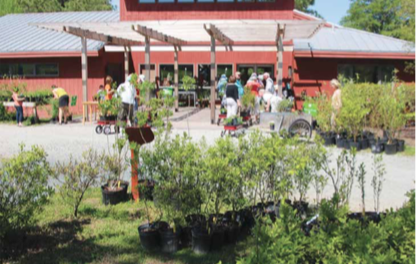
Lunar planting follows the old adage of planting certain crops by either the phase of the moon.
Whether novice or seasoned veteran, gardening has been increasing in popularity.
Last year, average households spent about $100 more on gardening than the previous year, according to the annual trends report from industry group Garden Media.
“People are awakening to Mother Nature to find balance and peace and are awakening to our responsibility to help save the Earth,” the report said.
This awakening is drawing people outside, to reconnect to plants and gardening, and drawing plants inside, as house plants, terrariums and other greenery gets more attention through biophilic design.
Last year the National Gardeners Association reported 30 percent of households purchased a house plant and searches for indoor plants on Pinterest increased 90 percent.
Millenials spurred by desires to improve wellbeing, were responsible for a third of houseplant buys.
“They have become ‘plant parents’ with a sense of purpose and new connection to nature,” the report said.
Another way these budding gardeners are connecting to the earth is through the moon.
So-called moon-phase gardening or lunar planting is not a new concept; it follows the old adage of planting certain crops by either the waxing or waning moon cycle.
Plant annuals and vegetables producing above ground crops when the moon is waxing, from new to full.
Plant flowering bulbs, perennials, biennials and vegetables producing below ground crops when the moon is waning, from the day after it’s full until a new moon.
The practice also lends itself to design elements to feature the moon.
Light-colored plants such as lamb’s ear, white echinacea and white Muscari reflect moonlight and bring more glow to a garden at night.
Others, like evening primrose or Angel’s trumpet, bloom at night and add fragrance to the evening glow.
The report also suggests keeping biting bugs away with white marigolds, lavender and rosemary to enjoy the space without so many biting insects.
More people yearning to get outside and get in the dirt could have a profound impact on their day-to-day life.
Research shows Americans spend about 93 percent of their day indoors and children today spend half as much time outside as their parents did as children.
Basking in the glow of digital screens instead of the sun’s rays has its effects, physically and emotionally, with children at risk more than anyone.
To combat the temptation to tap, scroll or swipe, garden time is moving in screen time’s turf.
Working the dirt and caring for plants through an entire season teaches responsibility, patience, delayed gratification and healthy choices.
But we don’t need to unplug completely, especially if it helps us be better gardeners and stewards.
Responsible technology use can help gardeners through phone apps, automation, sensors, 3-D modeling, lasers, drones and plenty of other nifty gadgets.
Automated watering systems, robot mowers and weeders are just a few things on the horizon that will help gardeners do more of the tasks they enjoy and spend less time on what they’d prefer to avoid.
Being more efficient also has big impact on food waste.
Unfortunately, one-third of all food grown is wasted each year, which works out to about 1,600 pounds per person.
Gardening is one of the ultimate upcycling activities through composting, cover cropping and nutrient cycling.
While many species of native insects, especially pollinators and other flyers, are at risk, populations of invasive insects and plants are on the rise.
According to the U.S. Forest Service, invasive insects are putting 70 million acres at risk of major damage and their eradication efforts total $138 billion per year.
That puts an emphasis on defensive gardening strategies.
Diligent scouting to catch the bad bugs at early stages and growing more plants that encourage beneficial insects are part of the plan.
It means checking mulch, firewood, vehicles and even boots for hitchhiking invasive bugs when you’ve traveled out of the area or brought in new material.
Just letting part of your property “go wild” by not mowing is a passive strategy but still very effective.
In any case, purposeful gardening appears to be here to stay.




